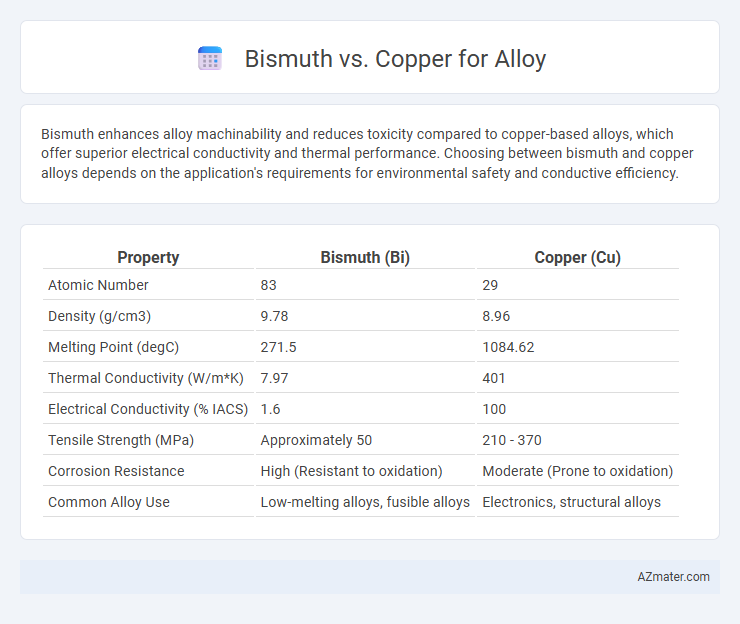Bismuth enhances alloy machinability and reduces toxicity compared to copper-based alloys, which offer superior electrical conductivity and thermal performance. Choosing between bismuth and copper alloys depends on the application's requirements for environmental safety and conductive efficiency.
Table of Comparison
| Property | Bismuth (Bi) | Copper (Cu) |
|---|---|---|
| Atomic Number | 83 | 29 |
| Density (g/cm3) | 9.78 | 8.96 |
| Melting Point (degC) | 271.5 | 1084.62 |
| Thermal Conductivity (W/m*K) | 7.97 | 401 |
| Electrical Conductivity (% IACS) | 1.6 | 100 |
| Tensile Strength (MPa) | Approximately 50 | 210 - 370 |
| Corrosion Resistance | High (Resistant to oxidation) | Moderate (Prone to oxidation) |
| Common Alloy Use | Low-melting alloys, fusible alloys | Electronics, structural alloys |
Introduction to Bismuth and Copper in Alloys
Bismuth and copper are key metals used in alloy production, with copper primarily valued for its excellent electrical conductivity, corrosion resistance, and strength. Bismuth, a brittle metal with low toxicity, is often added to copper alloys to improve machinability, reduce environmental impact, and enhance wear resistance. Copper-bismuth alloys find applications in plumbing, electrical connectors, and bearing materials due to their combined mechanical and anti-corrosive properties.
Chemical Properties: Bismuth vs Copper
Bismuth exhibits low thermal conductivity and high electrical resistance compared to copper, which features excellent electrical and thermal conductivity, making copper ideal for electrical applications. Chemically, bismuth is a post-transition metal with a relatively low reactivity and resistance to oxidation, whereas copper readily oxidizes to form greenish patina compounds like copper carbonate. In alloys, bismuth improves machinability and reduces toxicity, while copper contributes strength, ductility, and corrosion resistance.
Mechanical Characteristics and Strength Comparison
Bismuth alloys exhibit lower tensile strength and reduced hardness compared to copper alloys, making them less suitable for high-stress applications. Copper alloys typically provide superior mechanical properties such as increased yield strength and better fatigue resistance, beneficial for structural and electrical uses. The addition of bismuth can improve machinability and reduce toxicity in certain alloys but generally compromises overall mechanical strength compared to pure copper-based alloys.
Melting Points and Casting Behavior
Bismuth has a melting point of 271.5degC, significantly lower than copper's melting point of 1085degC, allowing bismuth to blend easily into copper-based alloys for lower-temperature processing. The presence of bismuth in copper alloys enhances casting behavior by reducing melting temperature and improving fluidity, which results in better mold filling and increased dimensional accuracy. Copper-bismuth alloys resist hot cracking and exhibit improved machinability, making them ideal for precision cast components requiring fine detail.
Corrosion Resistance: Bismuth-Based vs Copper-Based Alloys
Bismuth-based alloys exhibit superior corrosion resistance in acidic and neutral environments compared to copper-based alloys, which are more prone to oxidation and pitting corrosion. The presence of bismuth enhances the alloy's ability to form a protective oxide layer, reducing metal degradation over time. Copper-based alloys may require additional coatings or treatments to achieve similar durability in corrosive applications.
Electrical and Thermal Conductivity Differences
Bismuth has significantly lower electrical conductivity compared to copper, with copper exhibiting conductivity around 59.6 MS/m while bismuth's conductivity is approximately 1.3 MS/m, making copper alloys far superior for electrical applications. Thermal conductivity follows a similar trend; copper's thermal conductivity is about 400 W/m*K, whereas bismuth's thermal conductivity is only about 7.9 W/m*K, resulting in poorer heat dissipation in bismuth-containing alloys. These differences are critical when selecting materials for alloys used in electrical wiring or heat sinks, where copper alloys generally outperform bismuth-enhanced alternatives.
Environmental Impact and Toxicity
Bismuth is favored over copper in alloys for its low toxicity and environmentally benign properties, making it safer for applications requiring non-toxic materials. Copper, while highly conductive and durable, poses greater environmental risks due to potential heavy metal pollution and toxicity concerns in mining and disposal processes. The use of bismuth minimizes ecological footprint by reducing hazardous waste and bioaccumulation compared to copper alloys, promoting greener manufacturing and recycling practices.
Common Applications and Industry Uses
Bismuth-copper alloys are widely used in electrical connectors, plumbing fixtures, and ammunition due to their excellent conductivity, corrosion resistance, and low toxicity. Copper alloys dominate in electrical wiring, roofing, and marine applications because of high thermal and electrical conductivity combined with durability. Bismuth additions improve machinability and reduce environmental impact, making bismuth-copper alloys suitable for eco-friendly industrial components and precision engineering parts.
Cost Analysis and Material Availability
Bismuth alloys generally cost more than copper alloys due to bismuth's lower abundance and more complex extraction processes, impacting overall production expenses. Copper is widely available and mined extensively, resulting in stable prices and reliable supply chains, making copper alloys more cost-effective for large-scale applications. The price volatility of bismuth can increase manufacturing costs and limit its use primarily to specialized alloys where its unique properties justify the expense.
Choosing the Right Metal for Your Alloy Needs
Bismuth offers unique benefits in alloys, such as low toxicity, excellent machinability, and superior environmental safety compared to copper, which is highly conductive and corrosion-resistant. Copper alloys provide high electrical and thermal conductivity, making them ideal for applications requiring durability and efficient energy transfer. Selecting between bismuth and copper depends on specific alloy requirements like conductivity, toxicity, and mechanical properties to optimize performance and sustainability.

Infographic: Bismuth vs Copper for Alloy
 azmater.com
azmater.com